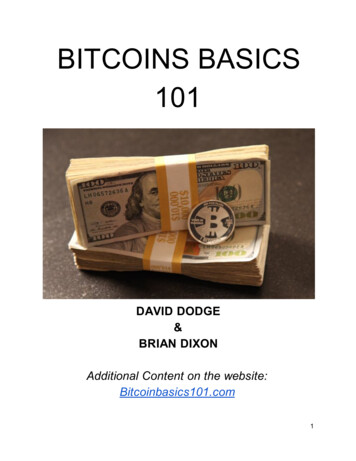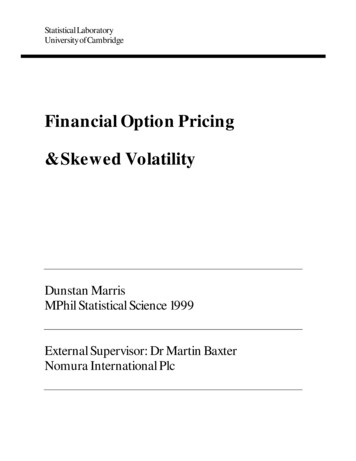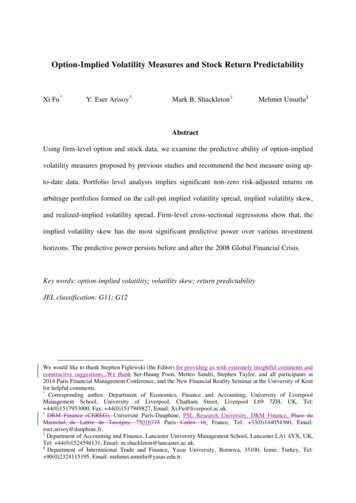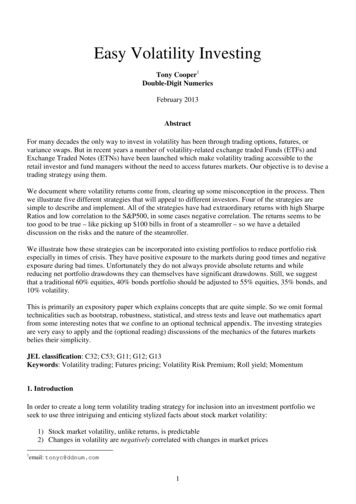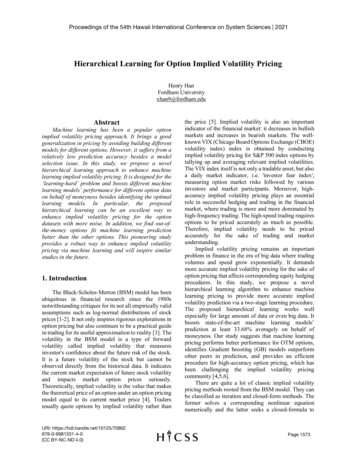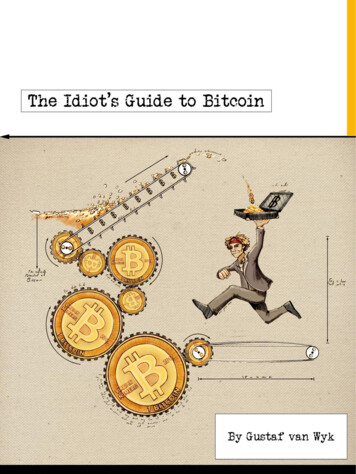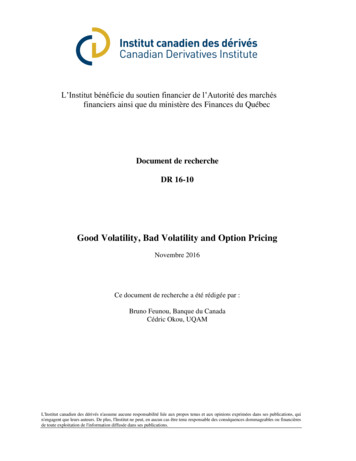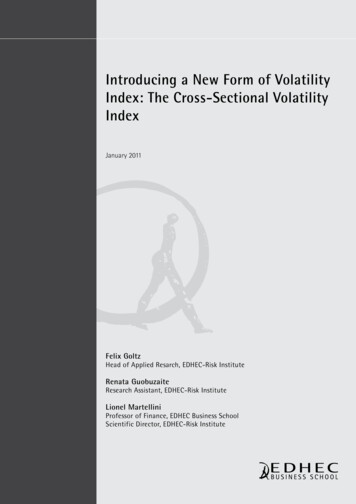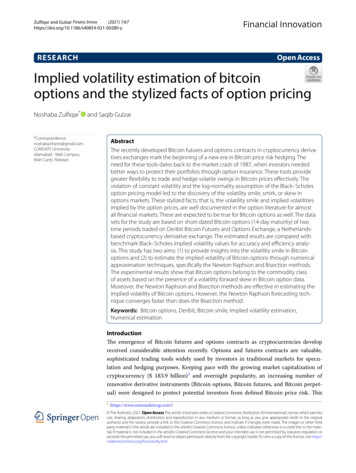
Transcription
(2021) 7:67Zulfiqar and Gulzar Financ ancial InnovationOpen AccessRESEARCHImplied volatility estimation of bitcoinoptions and the stylized facts of option pricingNoshaba Zulfiqar*and Saqib TS UniversityIslamabad - Wah Campus,Wah Cantt, PakistanAbstractThe recently developed Bitcoin futures and options contracts in cryptocurrency derivatives exchanges mark the beginning of a new era in Bitcoin price risk hedging. Theneed for these tools dates back to the market crash of 1987, when investors neededbetter ways to protect their portfolios through option insurance. These tools providegreater flexibility to trade and hedge volatile swings in Bitcoin prices effectively. Theviolation of constant volatility and the log-normality assumption of the Black–Scholesoption pricing model led to the discovery of the volatility smile, smirk, or skew inoptions markets. These stylized facts; that is, the volatility smile and implied volatilitiesimplied by the option prices, are well documented in the option literature for almostall financial markets. These are expected to be true for Bitcoin options as well. The datasets for the study are based on short-dated Bitcoin options (14-day maturity) of twotime periods traded on Deribit Bitcoin Futures and Options Exchange, a Netherlandsbased cryptocurrency derivative exchange. The estimated results are compared withbenchmark Black–Scholes implied volatility values for accuracy and efficiency analysis. This study has two aims: (1) to provide insights into the volatility smile in Bitcoinoptions and (2) to estimate the implied volatility of Bitcoin options through numericalapproximation techniques, specifically the Newton Raphson and Bisection methods.The experimental results show that Bitcoin options belong to the commodity classof assets based on the presence of a volatility forward skew in Bitcoin option data.Moreover, the Newton Raphson and Bisection methods are effective in estimating theimplied volatility of Bitcoin options. However, the Newton Raphson forecasting technique converges faster than does the Bisection method.Keywords: Bitcoin options, Deribit, Bitcoin smile, Implied volatility estimation,Numerical estimationIntroductionThe emergence of Bitcoin futures and options contracts as cryptocurrencies developreceived considerable attention recently. Options and futures contracts are valuable,sophisticated trading tools widely used by investors in traditional markets for speculation and hedging purposes. Keeping pace with the growing market capitalization ofcryptocurrency ( 183.9 billion)1 and overnight popularity, an increasing number ofinnovative derivative instruments (Bitcoin options, Bitcoin futures, and Bitcoin perpetual) were designed to protect potential investors from defined Bitcoin price risk. This1(https:// www. coinm arket cap. com/) The Author(s), 2021. Open Access This article is licensed under a Creative Commons Attribution 4.0 International License, which permitsuse, sharing, adaptation, distribution and reproduction in any medium or format, as long as you give appropriate credit to the originalauthor(s) and the source, provide a link to the Creative Commons licence, and indicate if changes were made. The images or other thirdparty material in this article are included in the article’s Creative Commons licence, unless indicated otherwise in a credit line to the material. If material is not included in the article’s Creative Commons licence and your intended use is not permitted by statutory regulation orexceeds the permitted use, you will need to obtain permission directly from the copyright holder. To view a copy of this licence, visit http:// creat iveco mmons. org/ licen ses/ by/4. 0/.
Zulfiqar and Gulzar F inanc Innov(2021) 7:67ultimately provides a wide range of return opportunities (Deribit 2020). Moreover, welldesigned strategies for cryptocurrency derivative instruments improve cost efficiency forpotential investors by replacing more capital-intensive strategies (Bitcoin-News 2019).Therefore, taking advantage of the host of opportunities from crypto-market volatility,especially Bitcoin market volatility, the trading of Bitcoin options, futures, and perpetualcontracts marks the beginning of a new era.Bitcoin options are in a nascent stage of development and traded on a handful of Bitcoin futures and options exchanges (Deribit,2 LedgerX,3 IQ options,4 Quedex,5 Bitmex,6Bakkt,7 and OKEX8 internationally to trade Bitcoin futures and options contracts. Therecent announcement of the Chicago Mercantile Exchange (CME) group to launch Bitcoin options on Bitcoin futures contracts in the first quarter of 2020 could be seen as away to help institutions and professional traders in a regulated exchange environmentmanages spot market Bitcoin exposure, as well as hedge Bitcoin futures (CoinDesk 2019;CME-Group 2020). In this context, Bitcoin options contracts are of immense importanceand are now widely adopted and acknowledged by option practitioners, cryptocurrencytraders, and policymakers as an effective tool to leverage assets or control portfolio riskby strategically hedging some portion of the risk.9Option valuation plays a fundamental role in managing portfolio returns. It providesa basis for a forecast that assists in rigorous decision making in portfolio management(Pagnottoni 2019). This is particularly true when dealing with the most volatile andimmature markets, especially the Bitcoin market. The most popular and widely acceptedBlack–Scholes option pricing model (Black and Scholes 1973) to determine the fairprice of an option (Rebonato 2004; Mayhew 1995) is studied extensively. Options studies are not limited to stock and bonds options; an extraordinarily broad and deep bodyof the options literature also examines currency options, commodity options, and eveninterest rate options (Mayhew 1995). The volatility smile, implied volatility surface, andvolatilities implied by the option prices are the key phenomena or the stylized facts studied for almost all financial markets globally in the context of option pricing (Jackwerthand Rubinstein 1996; Dupire 1994; Rubinstein 1994; Derman and Kani 1994b; Dupire1992). Hence, the existence and verification of these phenomena in the option pricingliterature motivated us to determine whether we observe the same stylized facts in themost actively traded, and highly volatile, cryptocurrency derivatives market, that is, theBitcoin options market. Therefore, Bitcoin options could be considered as important asstock, bond, commodity, currency, or interest rate options. To the best of our knowledge, the study of the stylized facts of option pricing for the newly developing Bitcoinoptions has not yet been addressed. Besides being an area of intense interest, the results23456789(https:// www. derib it. com/)(https:// www. ledge rx. com/)(https:// www. iqopt ion. com/)(https:// www. quedex. net/)(https:// www. bitmex. com)(https:// www. bakkt. com)(https:// www. okex/ en)(https:// news. bitco in. com/)Page 2 of 30
Zulfiqar and Gulzar Financ Innov(2021) 7:67of this study would be helpful in defining the appropriate asset class (equity, currency,commodity, etc.) for Bitcoin.The implied volatilities of Bitcoin options carry important information that is crucialfor decision-making process in portfolio management. The closed-form approximations, forecasting ability, and information content of implied volatility is a topic of greatinterest for option practitioners and academicians. Moreover, producing an accurateand reliable implied volatility forecast is central to derivatives market research, whichwill be true for the Bitcoin derivatives markets as well. There is an observed absenceof root-finding forecasting techniques in the financial literature for estimating impliedvolatility (Chance et al. 2016). This gap motivated us to estimate the implied volatility ofBitcoin options using root-finding iterative techniques, specifically the Newton Raphsonmethod (NRM)and Bisection method (BM). Notably, this is the first use of numericalapproximation techniques to estimate implied volatility for the cryptocurrency derivatives market, to the best of our knowledge.The data sets for the study emphasize short-dated Bitcoin options (14-day maturity),traded on Deribit Bitcoin Futures and Options Exchange, a Netherlands-based cryptocurrency derivative exchange. To address the issues of generalizability, which requiresthat we account for the prevailing macroeconomic market conditions, we analyze twodifferent periods: Bitcoin options traded from September 28 2019 to October 11 2019(dataset-I) and from March 7 2020 to March 20 2020 (dataset-II).To summarize, we lack a complete understanding of the stylized facts of option pricing(volatility smile and implied volatilities implied by options prices) for Bitcoin options.This study contributes to the cryptocurrency literature and option pricing literaturein two ways: (1) we verify the existence of widely accepted volatility smile in Bitcoinoptions and (2) we estimate the implied volatility of Bitcoin options using the NewtonRaphson and Bisection numerical approximation techniques. The results strongly suggest that Bitcoin options belong to the commodity class of assets based on the presenceof the volatility forward skew in Bitcoin options data.We employed Black–Scholes implied volatility (σBMIV ) as a benchmark for the accuracy analysis (Ewing 2010; Poon and Granger 2003; Isengildina et al. 2007; Li 2005). Itis calculated from the pricing error equation c(σ ) cM 0; by putting each observable variable into the Black–Scholes option pricing formula and iteratively finding theimplied volatility value (σBMIV ) that satisfies the zero difference between the predictedcall premium c(σ ) and the actual call premium cM . The results show that the newtonRaphson and Bisection numerical estimation techniques are effective in estimating theimplied volatility of Bitcoin options. However, the Newton Raphson forecasting technique converges faster than does the Bisection method for the at-the-money and out-ofmoney scenarios.The remainder of the paper is organized as follows. Section 2 provides a review of theliterature on Bitcoin and the estimation techniques to calculate implied volatility. Section 3 presents the research methodology along with the pseudo code of the NewtonRaphson method and Bisection method. Section 4 defines the data specifications. Section 5 outlines the stylized facts of option pricing for Bitcoin options. Section 6 describesthe implied volatility estimation of Bitcoin options and the pseudo code for the benchmark Black–Scholes implied volatility calculations. Section 7 concludes.Page 3 of 30
Zulfiqar and Gulzar F inanc Innov(2021) 7:67Literature reviewThe volatile movement of Bitcoin, exponential growth in returns, unique features, andincreasing use worldwide, marks the acceptance of the new crypto-world in recenttimes (Eross et al. 2019). Bitcoin’s trade trajectory can be traced back to a slice of pizzavia a Reddit thread to one of the hottest and debatable commodities in the financialmarket. Since the inception of Bitcoin by Satoshi Nakamoto (2008) through a groundbreaking white paper in 2008, Bitcoin represented the emergence of a new asset classand serves as a diversifier for many investment portfolios due to its low correlation withother traditional asset classes (Burniske and White 2017). In addition, the global investment bank Morgan Stanley10 claims to have added more weight to the cryptocurrencyprofile, stating that Bitcoin is the fastest-growing and best-performing asset class in thelast ten years, despite its large volatility swings 2017–2018, as it outperformed many ofthe best-performing traditional markets, including the S&P 500 index, Dow Jones, andNASDAQ. In this context, Bitcoin is no longer considered simply a payment system orfinancial system but a preferred choice of institutional investors as an emerging assetclass (Burniske and White 2017).In less than a decade, the cryptocurrency literature grew to cover multiple disciplinesby discussing the statistical or economic properties of Bitcoin and providing a detailedoverview of the technical issues of Bitcoin and other cryptocurrencies. A rather wide setof studies focuses on the interesting discussion of Bitcoin capabilities as a new financialasset class or an exciting investment opportunity, and whether it exhibits the characteristics of a currency more than a commodity. The majority of the users of Bitcoin treattheir Bitcoin investment as a speculative asset instead of considering it as a means ofpayment (Glaser et al. 2014). Therefore, one can view Bitcoin as a useful asset instead ofa currency. In contrast, Whelan (2013) claims that Bitcoin is similar to the dollar in thesense that both have no or limited intrinsic value and can be used primarily as a mediumof exchange. The only difference between the two is the centralization of the dollar andthe complete decentralization of Bitcoin as it was introduced by the private sector.Since the inception of Bitcoin, an extensive literature developed in the context of hedging capabilities and the safe-haven properties of Bitcoin in relation to other traditionalfinancial assets based on correlation. An early study on the Bitcoin market by Wu andPandey (2014) depicted its role in portfolio planning. This study uses the daily prices ofBitcoin and other stock indices for the July 2010–December 2013 period. By analyzingthe correlation and volatility of the Bitcoin market, the authors conclude that Bitcoin canbest serve as an asset class rather than a currency, and investors can add a portion of thisasset to a portfolio to enhance the portfolio efficiency. Baur et al. (2015) examined somespecific characteristics of Bitcoin and concluded that Bitcoin is a hybrid of a fiat currency and a commodity and unrelated to other financial assets like equities, bonds, andso on. The study finds that Bitcoin has no intrinsic value and works under an independent, self-governing mechanism. The study also highlighted the role of Bitcoin as a speculative investment and more as an emerging asset class than as a medium of exchange.Dyhrberg (2016a) explored the hedging capabilities of Bitcoin using GARCH models to10(https:// thene xtweb. com/ hardf ork/ 2018/ 11/ 01/ morgan- stanl ey- bitco in- asset/)Page 4 of 30
Zulfiqar and Gulzar Financ Innov(2021) 7:67reveal the relationships between Bitcoin, gold, and the dollar. The results suggest thatBitcoin occupies a place between a currency and a commodity. The reason being thedecentralized nature of Bitcoin and limited market size. Moreover, Bitcoin can be seenas a useful tool in portfolio management for making more informed decisions based onits hedging capabilities and for reacting symmetrically to good and bad news. Therefore,Bitcoin can be classified between gold and the dollar, on a scale from the pure mediumof exchange benefits to pure store of value benefits.Dyhrberg (2016b) further investigated the hedging capabilities of Bitcoin againststocks in the FTSE Index and US dollar. The findings suggest a clear place for Bitcoinin the market for portfolio analysis and risk management as a hedge against the FTSEIndex and US dollar. Moreover, Bitcoin has some specific speed advantages, includinghigh and continuous frequency trading throughout the week. Therefore, it can be addedto an already rich list of hedging tools available to analysts and policymakers to hedgemarket-specific risk. In response to Dyhrberg (2016a), Baur et al. (2017) replicated andextended the sample period to reveal the relationships between Bitcoin, gold, the dollar,and other financial assets. The study examined the statistical properties of Bitcoin withrespect to bonds, stocks, commodities, gold and the US dollar and showed that Bitcoinhas distinctively different return, volatility, and correlation characteristics than do otherfinancial assets including gold and the US dollar. The study also showed that Bitcoin ismore like an asset than a currency and is used explicitly for speculative investment.Briere et al. (2015) analyzed a diversified portfolio with Bitcoin along with traditionalassets and alternative investments. The exceptional low correlation of Bitcoin with otherassets and higher average return and volatility provides significant diversification benefits and may improve the risk-return characteristics of well-diversified portfolios. Thelow correlation of Bitcoin with other assets may place Bitcoin in the class of safe-haveninvestments. Bouri et al. (2016) also examined the hedging and safe-haven properties ofBitcoin by using a dynamic conditional correlation model for major world stock indices,bonds, oil, gold, general commodity index, and the US dollar index. The overall resultsdemonstrated that Bitcoin acts as an effective diversifier in most cases. However, thehedging and safe-haven properties may vary between time horizons. This study foundthat Bitcoin serves as a safe-haven against the weekly down movement in Asian stocksonly. Bouri et al. (2017b) examined the hedging capability of Bitcoin under global uncertainty using the first principal component of the VIX for developed and developing markets for different investment horizons. The wavelet and quantile-on-quantile regressionestimate results revealed a negative relationship between Bitcoin returns and globaluncertainty, leading to the conclusion that Bitcoin can help investors hedge global equitymarket uncertainty for short time. Selmi et al. (2018) explored the roles of Bitcoin as ahedge, safe-haven, or diversifier compared to gold under extreme oil price movementsby utilizing a quantile-on-quantile approach. The findings showed that both Bitcoin andgold would serve as a hedge, safe-haven, and diversifier against oil price movements.An exhaustive series of studies review the hedging capability and safe-haven property of Bitcoin in contrast with gold, the dollar, and other commodities in recent years.Among them, Shahzad et al. (2019b) addressed the most highlighted question of whetherBitcoin is a better safe-haven investment than gold and a general commodity index byconsidering several stock market indices in the US, China, and other developing andPage 5 of 30
Zulfiqar and Gulzar F inanc Innov(2021) 7:67emerging economies. The author proposes a novel definition of a weak and strong safehaven after utilizing bivariate cross-quantile algorithm approach. The results revealedthe time-varying nature of the safe-haven property for Bitcoin, gold, and other commodities, which differ across the stock market indices included in the study. The studyfurther opened the door by incorporating foreign exchange rates in relation to abovestated markets. Another comparative study by Shahzad et al. (2019a) on the safe-havenand hedging capability of gold and Bitcoin provided great insight for several G7 stockindices. Gold proved to be an undisputable hedge and safe-haven for many G7 stockindices, while Bitcoin served the same purpose for Canada. Moreover, the out-of-samplehedging effectiveness of gold surpasses that of Bitcoin and the conditional diversificationbenefits of gold in G7 markets are much higher and more stable than those of Bitcoin.Urquhart and Zhang (2019) analyzed the safe-haven and hedging capability of Bitcoinby accounting for the hourly frequencies of world currencies. Using an ADCC model,the study found Bitcoin to be an intraday hedge for CHF, EUR, and GBP. It acts as adiversifier for AUD, CAD, and JPY and a safe-haven for CAD, CHF, and GBP, even during extreme market conditions. Another study uncovering the hedging and safe-havenproperties of eight cryptocurrencies by Bouri et al. (2020a) explored the downsidemovement of the S&P 500 index and its 10 related equity sectors. The findings indicatethat many cryptocurrencies belong to a valuable emerging digital financial asset class. Tostudy the time-varying diversification ability of Bitcoin along with Ethereum and Litecoin against equities, Bouri et al. (2019) provided evidence that all three cryptocurrencies act as a hedge against Asia-Pacific and Japanese equities.A recent study by Naeem et al. (2020) focused on the safe-haven property and thehedging of the downside risk of commodities considering the functional role of cryptocurrencies. The results suggest the use of Ethereum, Litecoin, and Ripple along withBitcoin as a feasible hedge and safe-haven against price volatilities in commodities, especially the metals and agricultural groups. These cryptocurrencies are the least effectivefor energy commodities. Bouri et al. (2020b) examined the same characteristics for Bitcoin, gold, and a commodity index employing a wavelet coherency approach for globaland country-specific stock market indices. The results showed overall weak dependenceamong all, with Bitcoin being the least dependent. The diversification benefits studiedthrough wavelet value-at-risk (VaR) revealed the superior position of Bitcoin over bothgold and commodities. Conlon et al. (2020) conducted an interesting study in the context of the recent Covid-19 global Pandemic on the safe-haven characteristic of cryptocurrencies for equity markets. The study found that the inclusion of Bitcoin andEthereum increases portfolio downside risk, proving that these assets were not a safehaven for the majority of international equity markets during the Covid-19 turmoil, withthe exception of the Chinese CSI 300 index. In comparison, Tether acted as safe-havenfor all international indices studied.Bitcoin was also studied extensively in the context of highly speculative and volatilecryptocurrency markets. Baek and Elbeck (2015), Bouoiyour and Selmi (2015), Dwyer(2015), Katsiampa (2017), Bouri et al. (2017a), Pichl and Kaizoji (2017), Ardia et al.(2019) used ARCH-GARCH volatility analysis to explore the time series of Bitcoin.A significant contribution in studying the price dynamics and speculative trading inBitcoin is made by Blau (2017). Similar to the stock price crash (Wen et al. 2019),Page 6 of 30
Zulfiqar and Gulzar Financ Innov(2021) 7:67speculative bubbles in the Bitcoin market, as illustrated by Cheah and Fry (2015), provides another great insight. Another stream of literature related to Bitcoin price formation includes the work of Madan et al. (2015), Ciaian et al. (2016), McNally (2016).Many studies (Grinberg 2011; Baek and Elbeck 2015; Chu et al. 2015; Lam and Lee2015; Halaburda 2016; Bariviera et al. 2017; Burniske and White 2017; Trimborn et al.2019) emphasized the statistical or economic dimensions of Bitcoin. Further studiesby Bartos (2015), Urquhart (2011), Nadarajah and Chu (2017) provided importantinsights on the efficiency or inefficiency of Bitcoin in terms of the efficient markethypothesis. Shaikh (2020) studied the effect of economic policy uncertainty in the US,UK, Japan, China, and Hong Kong on Bitcoin returns.As Bitcoin options are at a nascent stage of development, so is the emerging literature related to Bitcoin options implied volatility estimation. Therefore, researchersand practitioners are increasingly interested in the potential to explore the sophisticated tools traded in cryptocurrency derivative markets globally. The recent work onBitcoin options and futures markets by Geman and Price (2019) highlights the maincharacteristics of cryptocurrency spot and derivatives markets. This study in particular investigates the storability and convenience yield of Bitcoin. The study further discusses the arbitrage approach to the valuation of Bitcoin and compares the futuresand options prices on old and new exchanges.Machine learning methods are emerging techniques in financial risk analysis (Kouet al. 2014), financial market regulation (Kou et al. 2019), and trade-based moneylaundering (Chao et al. 2019). Pagnottoni (2019) presents Neural Network Modelsfor implied volatility estimation of Bitcoin options. By highlighting a comparativeapproach of Neural Network Models with parametric models (binomial and trinomialtree models, finite difference methods and Monte Carlo simulations), the study provesNeural Network Models to be the best estimator of Bitcoin options implied volatility. Moreover, Hou et al. (2019) worked on the pricing of cryptocurrency options andpresents the case of Bitcoin and CRIX. The study by Shadab (2014) presented work onBitcoin regulation and block chain derivatives.Considering the importance and wide scope of the underlying study, the attemptto precisely estimate implied volatility is central to derivatives market research. Thisholds equally true for the emerging Bitcoin derivative market. The options pricingliterature has several modifications and approximations since the inception of theBlack–Scholes option pricing model (Jiang and Tian 2005; Chambers and Nawalkha2001; Britten-Jones and Neuberger 2000; Beckers 1981; Brenner and Subrahmanyam1988; Chiras and Manaster 1978; Chance 1996; Corrado and Miller 1996; Bharadiaet al. 1996a) to estimate implied volatility with improved precision and accuracy.With the advent of options knowledge, many works study non-parametric modelsto estimate implied volatility, including Artificial Neural Networks (ANN) (Liu et al.2019), Genetic Algorithm (Chen and Lee 1997), Back-propagation Neural Network(J.Yao and C.L.Tan 2000), and Sidarto (2006) and the RBF Neural Network (Yan andJianhui 2016). Jiang (2001) and Berry and Zuo (2009) studied the Bisection algorithmto precisely estimate implied volatility. Unfortunately, all estimates of implied volatility are only an estimate and are subject to an error tolerance and exhibit efficiencyissues (Chance et al. 2016). Therefore, Chance et al. (2016) mentioned the absence ofPage 7 of 30
Zulfiqar and Gulzar F inanc Innov(2021) 7:67Page 8 of 30precise root-finding forecasting techniques in the financial and options pricing literature for estimating implied volatility.The present study attempts to contribute to the growing literature on Bitcoin options,cryptocurrency derivatives, and options pricing by exploring the stylized facts ofoptions pricing, considering the volatility smile in the emerging Bitcoin options, specifically traded on Deribit Bitcoin Futures and Options Exchange. This study estimatesthe implied volatility of Bitcoin options using the Newton Raphson method and Bisection method as numerical approximation iterative techniques. To our knowledge, thisstudy is the first to discuss the stylized pattern of implied volatilities and to use numerical approximation iterative techniques to attempt to estimate the implied volatility ofDeribit-exchange-traded Bitcoin options.Research methodologyThe Black–Scholes–Merton option pricing model (Black and Scholes 1973; Merton1973) is widely used to determine the fair price of an option. However, the strict set ofmodel assumptions and subjectivity with respect to the parameter choices often yieldsvolatility smiles, skew, smirks, and leptokurtic behavior of the return distributions. Thesekey features are not captured by the simplest Black–Scholes–Merton formula. However,the Black–Scholes–Merton option pricing model is considered to be the cornerstone ofoptions pricing studies (Rebonato 2004). We also employ this traditional model to studythe key features of options pricing in a cryptocurrency derivative market, specifically theBitcoin options market. This model finds the value of an option in a frictionless marketusing a portfolio of options under arbitrage-free-conditions, as follows:c SN (d1 ) Ke rτ N (d2 )d1 ln(S/K ) (r (σ 2 /2))τ σ τ d 2 d1 σ τ ,(1)(2)(3)where c is the call option price, S is the Bitcoin price, K is the Bitcoin option strike price,r is the risk-free interest rate, τ is the remaining time to maturity, σ is the volatility of theBitcoin returns, and N(.) is the cumulative normal density function.This model can also be used to estimate the volatility of the underlying assets byreverting the process and using the observed market prices for traded call options. Bysetting the model call price c to the observed market price cM , the implied volatility isthe implicit solution ofcM SN (d1 ) Ke rτ N (d2 )ln(S/K ) (r (σ̂ 2 /2))τ σ̂ τ d2 d1 σ̂ τ ,d1 (4)where σ̂ is the implied volatility that forces the market observed price to be equal to themodel call price.
Zulfiqar and Gulzar Financ Innov(2021) 7:67Because there is no analytical expression to extract the implied volatility from theBlack–Scholes formula, many significant studies (Chambers and Nawalkha 2001; Bates1996; Hallerbach 2004; Kelly 2006; Corrado and Miller 1996; Li 2005) aimed to developclosed-form approximations of implied volatility by relaxing certain assumptions ofthe Black–Scholes–Merton model. However, the results are not useful for large-scaleresearch and trading (Chance 1996). Some recent works focused on the Genetic Algorithm (Chen and Lee 1997) and Sidarto (2006), RBF Neural Network (Yan and Jianhui2016), or ANN (Liu et al. 2019) to approximate implied volatility with improved precision and accuracy. These methods require a large amount of training and validationdata, which makes it effective only for spreadsheet and pedagogical applications. In thisbackdrop, Chance et al. (2016) proposed numerical root-finding iterative techniques toestimate implied volatility, which few studies in the finance literature apply to solve suchproblems. Two well-known root-finding techniques are the Newton Raphson methodand the Bisection method (Kritzman 1991). Chriss (1997) and Figlewski et al. (1992)referred to the Bisection method to estimate implied volatility. Other root-finding methods include the Secant method (Chabert 1999), Regula Falsi method (Chabert 1999), andthe Dekker–Brent method (Brent 1971) to get accurate estimates of implied volatility.This study at
interest rate options (Mayhew 1995). e volatility smile, implied volatility surface, and volatilities implied by the option prices are the key phenomena or the stylized facts stud - ied for almost all nancial markets globally in the context of option pricing (Jackwerth and Rubinstein 1996; Dupire 1994; Rubinstein 1994; Derman and Kani 1994b; Dupire
